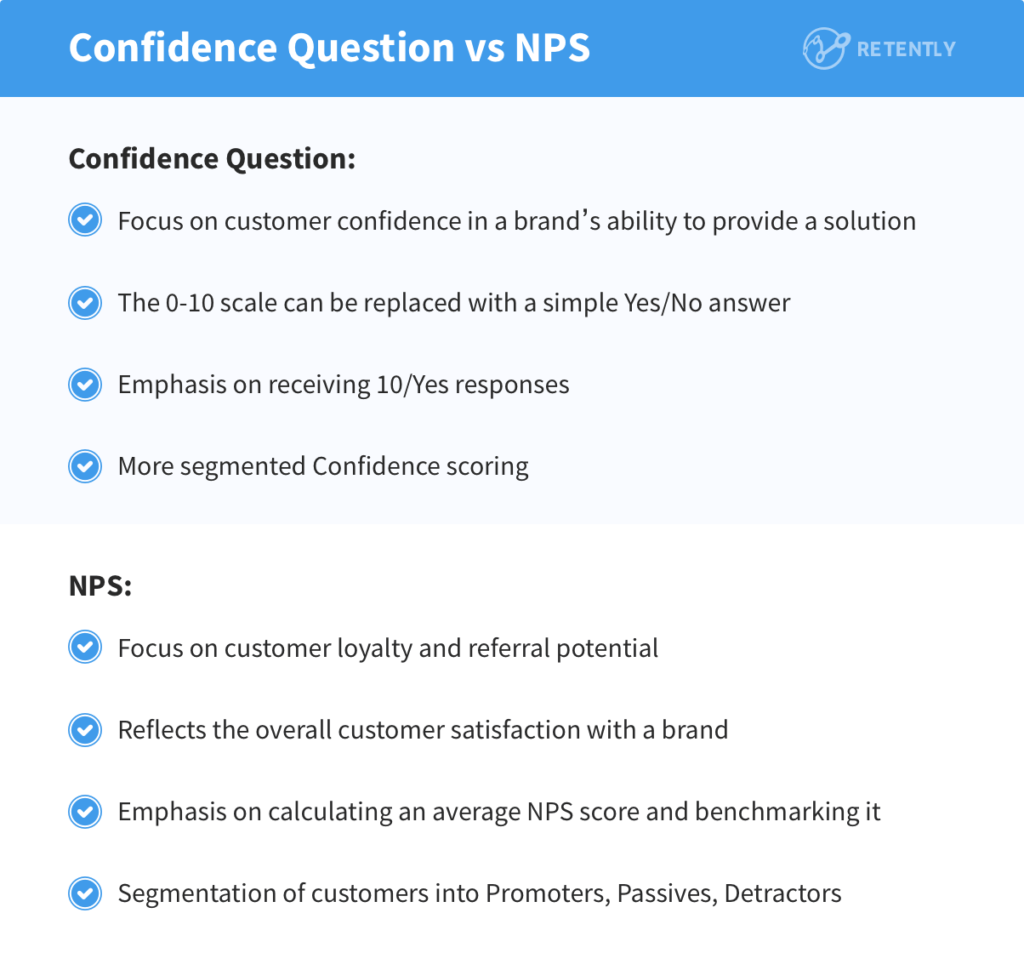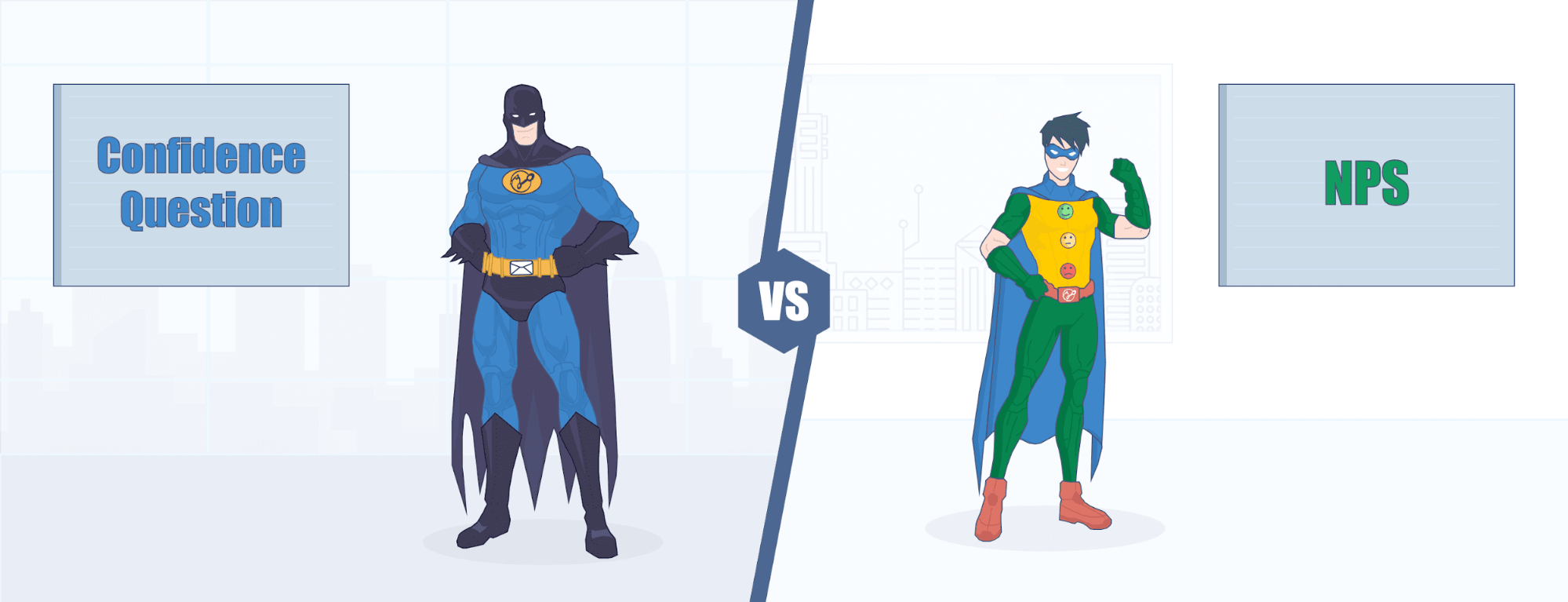Even though NPS® (Net Promoter Score®) is a great metric, there are people who think it has its fair share of issues. Lincoln Murphy (a well-known customer success professional and keynote speaker) is one of them, and he actually came up suggesting a new metric – the Confidence Question – to be used instead of or alongside NPS. Here’s everything you need to know about it, together with the main differences between the two.
The Confidence Metric
Here’s the given reason why this new metric should be used: Essentially, businesses need to focus more on how confident their customers are in their ability to offer them a solution – not on how happy they are with their brand. The goal for any business is to make sure clients have 100% confidence in their service/product. Anything less is a problem.
The Confidence Question would follow the same format as an NPS question with some minor alterations: “On a scale of 0 to 10, how confident are you that our product/service can help you meet your goals within the following weeks/months/years?” A shorter version (“How confident are you that our service/product can help you?”) can be used too. Also, the 0-10 scale can be replaced with a simple Yes/No answer.
The Confidence scoring would be a bit more segmented than NPS, though:
- 10 – Ideal result.
- 8-9 – Good result, but you should find out why your customers didn’t give you a “10”.
- 6-7 – Average result which hints at the client not being sure your solution is really what they need. You have to look into what exactly is harming your customers’ confidence.
- 0-5 – Concerning score which can potentially be associated with future customer churn if you don’t act on it.
Unlike NPS, there really isn’t any focus on calculating an average Confidence score or benchmarking it. The most important thing is to make sure you’re getting 10/Yes responses. If you’re not, you need to look into why that is happening (maybe it’s a problem on your end, but it can also be an issue on the customer’s end).
When it comes to implementing the Confidence Question across various channels, you’ve got a number of options:
- Emails
- In-app pop-ups
- NPS surveys (as an additional question)
- During QBRs
- Phone calls
Why should the Confidence Question be used over NPS? Well, this type of question allegedly has better response rates than NPS. There’s also a chance that this metric can better predict churn and expansion revenue. But is it really the case?
To test the waters we decided to survey our customers using the Confidence Question and compare the results with the ones received in a regular NPS campaign. Thus, our audience was asked the following question: “On a scale of 0 to 10, how confident are you Retently can help you meet your goals within the following months.”
Starting with the assumption that the Confidence Question has better response rates, our test campaign has proved it wrong. Moreover, it accounted for almost twice less response rate as compared to a regular NPS campaign.
The scores mostly correspond in both campaigns, irrespective of the difference in response rate. Thus, the customer perception of our brand has not been affected by the change in the question itself. In this respect, the Confidence Question served as a complementary means of double checking the results of the NPS campaign.
However, one of the comments received in the Confidence Question campaign, seems to point out the difference. The client submitted a 5 and explained, that the reason behind the score is not related to any shortcomings of the app, bad customer service or any negative experience along the way, but to the lack of confidence in the fact that the NPS framework can bring in the expected results in the following months. This example perfectly reflects the difference in focus for the two metrics: confidence in the ability to provide a solution with the proposed framework VS the overall satisfaction with your brand.

To get a better understanding of the existing differences, let’s move on and dive into Net Promoter Score.
What NPS Does Well & a Quick Look at Its Shortcomings
Some people believe that NPS can’t deliver good results, and that it’s best for companies to stop using it. Well, we’ll take a closer look at some of the problems you could encounter with NPS in case you only focus on it to see if things really are that bad.
Also, we’ve already mentioned how you can achieve great results with NPS by closing the feedback loop, using NPS to drive sales, using NPS in the VoC process, incorporating NPS in your product roadmap, so we won’t dwell on those topics in here. Instead, we’ll start out by taking a look at one thing NPS really does well which we haven’t talked a lot about yet.
NPS Is Directly Correlated with Revenue Expansion
Based on data from over 2,000 companies and 10,000 subscription-based users, ProfitWell has shown that a business’ NPS score can be linked to its revenue expansion. According to the report:
- Companies with a lower NPS score tend to only see a monthly 9% revenue expansion;
- Businesses with a middle/average NPS score see a revenue expansion rate of about 14% per month; and
- Companies with a high NPS score see an approximately 24% boost in the monthly revenue expansion.
Expansion revenue is basically the extra profit you can generate of a customer beyond the initial fees they pay for your product/service. So, NPS can be a good growth indicator for CLV (Customer Lifetime Value) rates.
Besides that, it’s also very likely that NPS is correlated with revenue expansion because NPS surveys allow you to collect direct feedback from your customers – feedback you can quickly act on to provide existing clients a better experience. In turn, that makes it more likely for them to spend more money on your product/service.
Also, since NPS segments customers into Detractors, Passives, and Promoters (basically upset, neutral, and happy customers), it makes it easier for you to prioritize the received feedback depending on your current goals (if you want to keep non-customers or upset customers from defecting or if you’d rather focus on growing brand loyalty among neutral clients and drive referrals from loyal customers).
The NPS Score Doesn’t Always Matter
Lincoln Murphy’s statement about NPS fits pretty well here: “I see companies with high NPS that have high churn and I see companies with low NPS with amazing retention and expansion.” Yes, there’s always a possibility that you might have a low or average NPS score, while your customer retention levels would be high and your churn levels low.
However, context is very important. Something like that could happen if, for example, you offered a service in a niche industry, you were the only one doing it, and you either didn’t survey clients too often or your response rate was low.
The simple truth is that the NPS score is a pretty volatile metric. For instance, even the survey channel can impact the results you’ll get. A survey done over phone might get a better NPS rating since people tend to offer more positive responses in real-life discussions. Plus, the response rate would likely be higher. On the other hand, an email or in-app survey could potentially get a lower response rate, and clients could be more critical with their ratings.
So, the lesson here is that you shouldn’t only rely on your NPS score as a measurement of how successful your business is. You also need to consider other factors like your industry, the type of product/service you offer, your competition, how easy it is for your customers to defect to another brand, and so on. Also, you shouldn’t track NPS just for the sake of doing it. The score also needs to be properly benchmarked against your industry average, and tracked alongside other success metrics.
NPS Isn’t Fully Accurate When It Comes to Retention and Churn
According to the same data from ProfitWell, NPS doesn’t seem to have a strong correlation with customer retention and churn. As it stands, there isn’t a huge difference between companies with average and low NPS scores when it comes to churn and retention rates.
Only companies with a very high NPS score seem to stand apart since they tend to have slightly lower churn rates and a 5-10% boost to retention.
Overall, it can be difficult to predict churn and retention if your NPS score is low or average. Still, you might have slightly better results if your NPS score is already pretty high or if you manage to increase it (say somewhere around over 60-70). Just don’t expect that your high NPS score is the only reason you have great retention and low churn rates. Also, that doesn’t mean that if you have a high NPS score, you no longer need to focus on improving retention and decreasing churn.
Also, here’s something else you should consider – NPS is a lagging indicator, meaning that it records your company’s performance after an event has already occurred. For example, if your NPS is very low, it’s very likely you’ve already lost customers. So, if you focus only on your NPS score to predict and lower churn, it’s not going to work in your favor. Instead, you should work on improving leading indicators (subscribers, page views, active users, sales growth, etc.) to boost lagging indicators like NPS.
The One-Question Format Doesn’t Work for Everyone
NPS surveys follow the one-question format because it tends to get a better response rate (it’s expected that the rate drops by around 10% for each question that’s added), and because it doesn’t have a strong influence on the customers’ opinions and feedback.
Despite that, there are businesses that would prefer to tweak their NPS surveys to include an additional question or two. While follow-up questions are normally reserved for requesting additional opinions, some companies would rather ask those extra questions directly instead of having customers answer them only after the NPS question, or having the support team follow up with the customers.
Experts recommend adding the Confidence Question alongside the main NPS question in your NPS survey. It could be the kind of improvement said companies might want – especially if they aim is to measure customer confidence alongside customer loyalty and referral potential.
You Need a Proper Feedback Strategy in Place to Take Advantage of NPS
Many companies make the mistake of thinking that NPS is just a customer satisfaction and referral metric, and nothing more – that as long as you send out surveys regularly, add up the total score, and see a good result, the whole process is finished.
The reality is that NPS is a great way to collect valuable customer feedback. NPS surveys include follow-up questions to ask customers what improvements they’d like to see. Doing that is smart, but it’s not enough. You also need to collect all that feedback, store it into a database, and then convert it into an actionable format (like a PDF, slideshow, or infographic) so that you can share it across all departments in your company, and with stakeholders too.
Afterwards, tasks need to be prioritized – will the product development team add that new feature that was requested by a lot of customers, or will they first address a particular issue some clients have highlighted?
Without a plan like that in place, you won’t be able to use NPS to its full potential.
NPS and The Confidence Question – The Bottom Line
Even though NPS has some shortcomings, it’s nothing that makes the metric stop being valuable altogether. Most of those problems can easily be solved by tracking and analyzing other metrics instead of focusing solely on NPS.
Plus, the way the Confidence Question is presented doesn’t make it stand out too much from NPS. In fact, it looks like a slightly different take on the NPS metric, only instead of a focus on customer referrals and brand loyalty you have a focus on customer confidence. Other than that, the goal is similar – collecting valuable customer feedback that can help you improve a client’s overall trust in your brand. The recommended channels are similar too.
In the end, the Confidence Question shouldn’t be perceived as a new metric that will replace NPS. Instead, it makes more sense to treat it as a metric you can measure alongside NPS. Whether you send out separate surveys or include the question in your NPS surveys is entirely up to you. At the same time, you shouldn’t treat NPS as the only metric your business will ever need. It’s very useful, no doubt about that, but it works best when it’s tracked alongside other valuable customer and business metrics.
In case you’d like to implement a scalable NPS service that can help your business collect actionable feedback and predict revenue expansion, we welcome you to give our 7-day free trial a shot.






























 Alex Bitca
Alex Bitca 

 Greg Raileanu
Greg Raileanu 


 Christina Sol
Christina Sol 